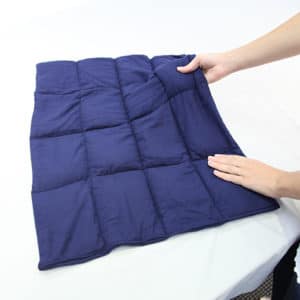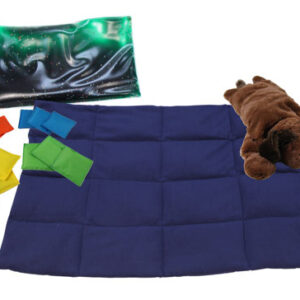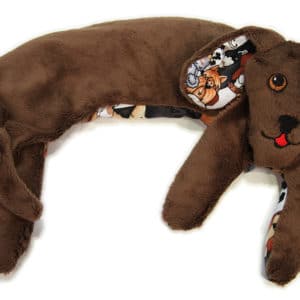Sensory Products
-
Weighted BlanketsSKU #3941WCozy and comforting, our weighted blankets enhance sensory integration, improve concentration and attention.$87.95 – $140.95
Select options This product has multiple variants. The options may be chosen on the product page
-
Weighted KitSKU #7024Weighted products such as the selection in this kit, provide sensory input that helps students with sensory processing disorders improve their attention and concentration.$209.95
Add to cart
-
Weighted Lap PadSKU #3165This 5-lb. weighted lap pad is made of super soft fleece and features two textures: bumpy on the blue side and smooth on the green side.$39.95
Add to cart
-
Weighted PuppySKU #3937A therapy dog that never needs to be walked! Just wrap this soft weighted pup around your neck and shoulders to experience calming pressure that helps with self-regulation, attention and concentration.$52.95
Add to cart
Importance of Sensory Toys for Kids With Autism
By providing children with autism spectrum disorder with the right toys and products meant to engage their senses and potentially make their day-to-day activities a bit easier, you can help them achieve more. Sensory toys for kids with autism are designed and built specifically for their unique needs, allowing your child to enhance their skills and stimulate their cognitive development.
Studies show that children with autism and sensory processing difficulties can benefit from sensory integration in classroom settings to help restructure their brains to adapt more effectively to sensory stimulation. Through the introduction and continued use of sensory toys, kids with autism may see dramatic improvements in many aspects of their daily life, including:
- Educational
- Social
- Emotional
- Behavioral
- Communication
In some children, using sensory toys to help them feel calm in certain environments can even make social interactions and emotional regulation easier. In a study where teachers used sensory toys in their classroom for kids with autism, researchers found that using the tools on a regular basis improved children’s focus, comprehension and overall functioning ability.
In addition, teachers noted that allowing students to use the sensory tools during learning time kept them stimulated and engaged in the activity at hand and were more physically and cognitively attentive. This research suggests how important sensory tools are for redirecting physical and emotional energy and improving concentration in children with autism.
Sensory toys for kids with autism and special needs can be a useful and valuable mediator tool for interactions with adults. A 2020 study on communication in children with autism showed that kids may use sensory toys as a way to engage in a sensorial experience, such as listening to the noise from a toy, to self-stimulate.
How Can Children With Autism Use Sensory Products?
There are many different ways kids with autism can use sensory toys and devices. Sensory play is an important activity for all kids to engage in because it allows children to stimulate and engage their senses in an enjoyable way. While sensory toys can help children calm down and focus better, they may also help them learn more about their senses and how to manage them.
You can use these devices with your children or students and encourage them to explore different senses by:
- Touching different objects and surfaces
- Hearing or feeling the sound or vibration of music
- Identifying new smells
- Introducing themselves to various colors and smells
- Feeling comfortable with trying something new
- Practicing using muscles in their hands, fingers and mouth
Types of Sensory Products
Sensory products for kids on the autism spectrum and other special needs can be categorized based on the sensory systems. They include the following.
1. Auditory: Hearing and Sound
Your occupational therapist may suggest auditory sensory products for your child to use at home and school if they are sensitive to auditory output. Some of the most common auditory products include:
- White noise machines: A white noise machine relieves stress and anxiety caused by overstimulating ambient noise. It can mimic calming sounds like rushing waterfalls, crickets chirping, wind blowing through trees or fans blowing air.
- Noise-canceling headphones: Noise-cancelling headphones combat auditory stimulation by muffling and reducing ambient sounds.
- Drums of different shapes and sizes: Drums of different shapes and sizes can help improve a child’s auditory processing.
- Earplugs: Earplugs are a safe, comfortable way to block out sounds, promoting calmness and controlling auditory stressors. They also help improve concentration by limiting distractions.
- Boom whackers: Boom whackers are lightweight color-coded tubes with lengths corresponding to musical pitches. They’re a fun, creative way to learn about sound and develop auditory processing.
These options help children engage with new sounds in a fun and interactive way, allowing them to increase their comfort with auditory inputs.
2. Olfactory: Smell
Scents can stimulate our memory, help us identify foods and flowers and alert us to danger. Products that stimulate the olfactory sense may be integrated into a child’s daily routine, placed in a room or worn with clothing, including:
- Scented pencils: Scented pencils are ideal sensory toys for a learning or creative environment. Each pencil has a unique scent, such as bubble gum, watermelon, black cherry or pineapple. They can help some children on the autism spectrum learn to recognize different scents.
- Scented bubbles: Scented bubbles engage multiple senses at once, including sight, smell and touch. They can help a child on the autism spectrum or with other special needs develop joint attention skills.
- Scented chewies: Chewy toys give children on the autism spectrum something they can safely chew on for stress relief, made from food-grade materials. Scented chewy toys help create scent associations and develop oral motor skills.
- Scented markers: Scented markers are perfect for art therapy, helping associate scents and colors.
- Scented dough: Molding, rolling, kneading and flattening dough relieves stress and refines motor skills. Adding scents can supplement the calming effects.
Working with objects that have different smells can give children the tools to process these new sensory stimulations and begin to tolerate and engage with them.
3. Oral-Motor: Chewing
Oral motor activities include chewing and sucking. They provide proprioceptive input to the child’s jaw. Some of these sensory products can be used to promote replacement behaviors for chewing non-food objects and clothing. Some oral-motor products include:
- Chewelry: Chewelry, as the name suggests, is chewable jewelry. It provides a safe alternative for children who tend to chew on non-food-grade items. Because it’s wearable, chewelry is easy to access all day long. If you’re looking for stress-relief toys you can take on the go, chewelry is a good choice.
- Chew beads: Chew beads are a popular form of chewelry. You can find them as necklaces or bracelets.
- Horns and whistles: Horns and whistles stimulate the auditory sense while exercising the facial muscles and lips. You can find a wide range of different horn and whistle toys, each producing unique sounds.
- Electric toothbrushes: Electric toothbrushes stimulate multiple senses with their textures, colors and vibrations. These helpful sensory toys promote oral hygiene.
- Bubble blowers: Bubbles are visually stimulating and fun. They also help certain children on the autism spectrum learn to make round lip shapes and control their breath, both skills necessary for speech.
These toys provide sensory stimulation that enables children to use their lips and jaw muscles for sucking and chewing exercises.
4. Visual
Visual products can assist children and adults in staying calm and focused while preventing visual overload on their eyes. These visual toys should be included in any sensory toolbox:
- Light and movement projectors: Light and movement projectors create mesmerizing visual displays for calming purposes.
- Different types of mazes: Mazes are excellent visual puzzles that help develop problem-solving and critical thinking skills.
- Puzzles: Puzzles of any kind are ideal children’s toys, promoting critical thinking and spatial relation awareness.
- Spirographs: A spirograph is a geometric drawing device that helps introduce children to math and shapes.
- Liquid motion toys: Liquid motion toys move in response to a child’s touch — they work well as sensory fidget toys.
- Bubble tubes: Bubble tubes contain ever-changing bubble displays to help with color recognition and visual development.
With creative ways to engage their visual perception, visual sensory toys allow kids to become more comfortable with visual stimuli while staying calm.
5. Tactile: Touch
Deep touch and deep pressure tools can stimulate the tactile receptors. Stimulated tactile receptors can release serotonin in the brain to improve mood and help sensory regulation. Examples of tactile sensory products include:
- Ball pits: Ball pits provide an immersive tactile experience involving the entire body.
- Ball chairs: Ball chairs are a fun way to promote muscle development and balance.
- Weighted lap pads: Weighted lap pads help children on the autism spectrum stay calm and focused in a learning environment or elsewhere.
- Weighted blankets: Weighted blankets have calming qualities, providing deep pressure.
- Vibrating massagers: A vibrating massager creates sensory interest and stress relief.
- Scalp and skin massagers: Scalp skin massagers are a popular form of massager for calming purposes.
- Back scratchers: Back scratchers can stimulate tactile senses in harder-to-reach places, meanwhile discouraging harmful scratching.
Products that apply these types of pressure can help children relax and grow more comfortable with tactile experiences as they touch different textures in other environments.
Get the Best Sensory Toys for Kids With Autism at Enabling Devices
At Enabling Devices, we offer trusted products that can benefit children on the autism spectrum and other sensory needs. As leaders in the assistive devices field, we’ve been committed to creating vibrant solutions for children with disabilities for more than 40 years. Our goal is to create products that engage the imagination, build cognitive and motor skills, and help kids and adults become comfortable with new sensations.
Whatever your requirements, you can trust us to provide unparalleled support and innovative sensory toys for kids and adults with special needs. Explore the options we have available.
If you think your child could benefit from and enjoy using a different type of product for a specific issue, we also offer customization. We can design new sensory toys for children with autism and special needs to enhance their communication or sensory requirements. Contact us to learn more about our customization services!







